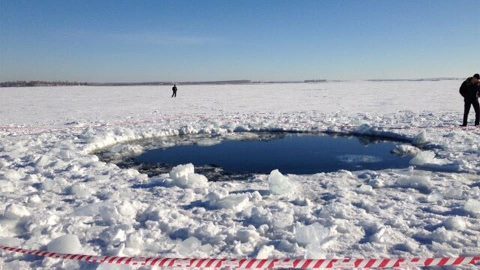The image shows local authorities standing near the 6-metre hole on Chebarkul Lake, identified as a possible landing zone for a meteorite fragment. The RIA Novosti news agency has reported that 3 impact sites have been found for some of the fragments of the Chelyabinsk meteor. Two impact sites were found near Chebarkul Lake and the other site is near Zlatoust, a town 80 kilometres northwest of Chelyabinsk. Small black fragments have been recovered for the ice by scientists and police; they will be studied further to determine whether they are indeed part of the meteor’s debris. Some people have linked to a video purporting to show the meteor impact as a fiery pit; this video is actually of Darvaza gas crater in Karakum desert in Turkmenistan, which has been on fire for the last 41 years. Read more about Darvaza here:http://on.fb.me/Voyivx
The meteor was the largest in a century; the Russian Academy of Sciences estimated the meteorite weighed about 10 tons and entered the Earth’s atmosphere at a speed of at least 54,000 km/h (33,000 mph), exploding about 30-50 kilometres above the ground. The rock was too small for any advance-warning networks to pick it up; the network of telescopes that watches for asteroids that might strike Earth is geared towards spotting objects between 100 metres and a kilometre in size. The object was large enough for infrasound data collected by the Comprehensive Test Ban Treaty Organization, a network designed to watch for nuclear weapons testing, to show that the blast released hundreds of kilotonnes of energy. This makes the blast more powerful than the nuclear weapon tested by North Korea a few days ago and the largest meteor explosion on Earth since a meteor broke up over Siberia’s Tunguska River in 1908.
The meteoroid was about 15-17 metres in diameter when it entered the Earth’s atmosphere. The meteoroid may also have contained nickel and iron and is likely to have come from the asteroid belt, a region located between Mars and Jupiter that contains hundreds of thousands of rocky bodies. The timing of the meteor and its location suggest it came from a different direction than the large asteroid called 2012 DA14 that safely flew by Earth on 15 February. The majority of damage in the Chelyabinsk region was caused by shockwaves of the explosion when the rock broke up in the upper atmosphere, and not due to the meteorite fragments. The infrasound data shows the meteor had a very shallow angle of approach; this funneled most of the energy from the blast to the city.

















